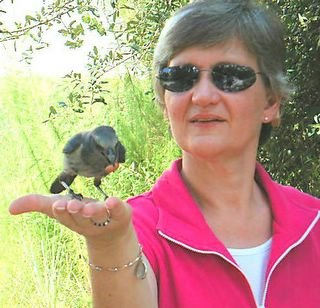I busied myself during the one-month recovery period between surgery and activation by learning Cued Speech. I reasoned that Gerry and I needed a means of communication that would help me with sounds that I might have trouble processing. Cued Speech is a system of hand placements used in conjunction with speech that corresponds with the 44 phonemes of English. Learning Cue has proven to be a wise and practical decision. Gerry uses it to “talk” to me late at night and early in the morning when the implant processor is not connected, or in noisy environments when I’m struggling to understand a word or sentence.
My parents joined us for the momentous day called “hook-up”. I was blessed with being able to hear most of the words of all those in the room from that long-awaited moment when all channels are activated, but no one’s speech possessed a human quality. Gerry’s was sort of a Darth Vader clone, and Mom’s voice did not even sound feminine. But I was thrilled! Let the adventure begin!
Each subsequent “mapping” session at Johns Hopkins was both encouraging and challenging. Joy and amazement swept over me when we compared my pre-implant audiogram and my current post-implant audiogram. Scores on tests of repeating single words had risen from 6% to 84% in just six months! After auditory testing came the exhausting work of “re-mapping” as the audiologist attempted to make program adjustments to address my complaints. It was no easy task for me to accurately describe what I had been hearing that didn’t sound quite right. Initially, both male and female voices sounded similar, like everyone was underwater, having a kind of a monotone “boink” attached to their words. As time passed, it changed to a muffled, fuzzy sound with a buzz like that produced by an oboe. With a later map, the words still seemed too resonant, like reverberation in an overdriven stereo speaker. But I knew the changes were in the right direction, toward the goal of human-sounding speech, and my brain was working overtime.
“What’s that sound?” was my perpetual question to anyone who chanced to be near me. I was like a toddler, alert to every sight and sound and curious about each new sound discovery. Inside my house, I discovered that my dog’s toenails made a clicking sound as she traipsed across the kitchen floor. The microwave beeped, the refrigerator hummed, the water cooler gurgled, and the wall clock audibly ticked away the seconds. The computer was not the silent technology I had always known. From its musical announcement of start up, to its thunk when I click on the wrong thing, or its chattering as my fingers depressed the keys. Who would have thought? The companion printer was also a noisy machine, producing rumbling and chirping sounds in addition to the light and motion and, eventually, the printed page.
The outside world was an even greater wonder. Traffic noise and the roar of airplanes overhead became annoying noise pollutants that interrupted my investigation of more pleasant sounds. Last season’s grasses in a nearby meadow made a crunching noise under my feet. There was a veritable serenade to experience when walking in the woods as twilight approaches: twigs snapping underfoot, leaves rustling with each gust of wind, and tree frogs and cicadas announcing their presence with a continual concert. There was something soothing and serene about listening to the sound of a tiny stream as its crystal clear water trickled over the stones and wound its way downstream. And the birds… oh, the birds! Had their songs had such sweetness and energy when I heard them in my youth?
Gerry’s whistling and the crisp, tinkling sound of music boxes were a pleasure within the first week of “CI sound”, and especially when I began to recognize some of the melodies. I so longed to have music back in my life that I even made a trip to the local Costco store just to finger an electronic keyboard on display, holding my aux mic next to the speaker. A strange phenomenon occurred at various times on the descending scales: a note would go up instead of down. No wonder Gerry, who is gifted with a beautiful baritone voice, was now singing off key! Patience and practice, I’d tell myself. The music of “Peter and the Wolf” was the first recording that sounded somewhat like I remembered it. It was a great CD to use as a kind of aural therapy since it begins with the identifying of single instruments with their melody “lines” and has narration interjected throughout the score.
There was a longing during the first few months of CI sound for that promised return of more human-sounding voices. I had not expected to experience this yearning, a kind of grieving, I suppose, over the absence of that “natural” sound of speech. Though acutely aware of the rich blessing of comprehending most of what people said when I could see their faces, I still wanted to hear people sounding like people! I was only vaguely conscious of a gradual evolution occurring in my brain’s perception of speech, a subtle change from the Darth Vader men and the computerized women’s voices to a sort of tunnel-like, public address system quality to everyone’s speech. At about the time Gerry began to “sing well” again, I realized that people’s voices had more intonation and inflection than in previous weeks, and that my neighbor’s English accent and distinctive tone had returned. When we arrived home one evening from a visit next door, I recall telling Gerry, through tears of gratitude, “Angie sounds like Angie!”
